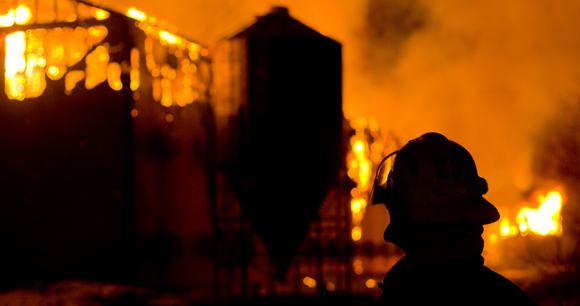
Majority of victims were cage-free hens
Washington, DC—More than 1.6 million farm animals, including nearly 1.3 million cage-free hens, have perished in potentially preventable barn fires so far this year, according to an Animal Welfare Institute (AWI) analysis of media reports released today. The 2020 tally of farm animal deaths from barn fires is the highest annual total since AWI began tracking barn fires in 2013 and is more than triple the number reported last year.
Since 2017, barn fires have taken the lives of approximately 4 million farm animals in the United States; the vast majority were egg-laying hens.
Though these numbers are shocking, they do not represent the full scale of the tragedy. The number of fires and animal deaths in recent years likely exceeds totals reported by the media, since municipalities are not generally required to report barn fires, and some companies decline to release the information to the public.
Currently, there are no US laws or regulations designed to protect farm animals from barn fires. While the cause of most fires is unknown, many are believed to result from electrical malfunctions or improperly placed or faulty heating devices. In fact, two-thirds of barn fires this year occurred during colder winter and spring months.
“It is completely unacceptable for the industry to tolerate massive numbers of animals burning to death when there are effective fire prevention and suppression strategies available,” said Dena Jones, farm animal program director for AWI.
Nebraska reported the most animal deaths from barn fires this year (400,000 in three fires), followed by Michigan (300,000 in eight fires), California (280,000 deaths in five fires), and New Jersey (280,000 in one fire). Of the 87 barn fires tracked by AWI this year, New York reported the most (10), followed by Pennsylvania (nine).
The four barn fires with the highest number of farm animal deaths (as reported by the media) all involved cage-free hens, even though less than 25 percent of all hens are cage-free:
- January 3: 300,000 cage-free hens at a Konos Inc. facility in Ostego Township, MI
- February 27: 400,000 cage-free hens at a Michael Foods facility in Bloomfield, NE
- April 23: 280,000 cage-free hens at a Gemperle Farms facility in Stanislaus County, CA
- July 20: 280,000 cage-free hens at Red Bird Egg Farm in Pilesgrove, NJ (*80,000 of these hens died in a neighboring building that lost power during the fire)
AWI is researching the causes of recent large fires that occurred at egg production facilities. As producers increasingly transition to cage-free housing, Jones suspects that high levels of dust, alone or in combination with litter, may contribute to the number and severity of fires in cage-free barns. Scientific research has documented dust levels up to nine times higher in cage-free housing compared to cage housing.
“It seems unlikely that the occurrence of fires in cage-free barns this year is merely coincidental,” said Jones. “Although AWI strongly supports eliminating cages for egg-laying hens, we recognize that cage-free housing under minimum industry standards presents certain challenges to animal welfare, including poor environmental conditions.”
In addition to egg-laying hens, barn fires affect other farm animals, including cattle, sheep, goats, pigs, meat chickens, ducks, and turkeys. Animals are housed at a variety of locations, from small hobby farms to large commercial facilities. Birds die in such large numbers as a result of factory-farming practices that confine tens to hundreds of thousands of animals under one roof.
Earlier this year, AWI and more than 10,000 consumers asked the US Poultry & Egg Association to assess fire risks and the adequacy of fire prevention and suppression at poultry facilities in the United States. The association’s president, John Starkey, has not yet responded.
“It is appalling that more than 1 million cage-free hens perished in barn fires this year,” said Jones. “AWI calls on the egg industry to address this problem as soon as possible so that the potential of improved welfare in cage-free housing can be realized.”
More information about barn fires and how they can be prevented is available on AWI’s website and in its comprehensive 2018 barn fire report.
Margie Fishman, (202) 446-2128, [email protected]